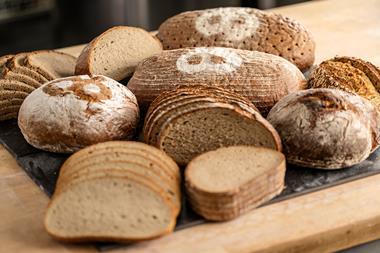Experts from Waitrose, Public Health England and the Waste & Resources Action Programme (WRAP) were among the speakers at the Federation of Bakers’ (FOB) annual conference last week.
Taking place at One Great George Street in Westminster on Wednesday 23 May, presentations ranged from health and sugar reduction to key bakery market trends, as well as wheat breeding and waste.
Here’s a round-up of some of the key take-home messages from the day:
Flour dust needs to be taken more seriously
Stress, musculoskeletal disorders and occupational lung disease are three of the core focuses of the Health and Safety Executive (HSE) right now.
When it comes to bakery, there is particular cause for concern regarding the latter.
“Flour dust is the second-largest cause of occupational asthma in the workplace,” Giles Hyder, HSE general manufacturing sector lead, told attendees. “In our research of SME bakeries, awareness of the health risk of flour dust is incredibly low.”
Besides the personal cost to those suffering from the condition, Hyder noted a cost to the UK economy and businesses – whether that’s through sickness or productivity losses.
As such, it has been earmarked for further work by the HSE, which “sees an opportunity to influence and create a change” in this area. While the basic advice for managing flour dust won’t be ground-breaking to bakers, Hyder said the HSE needed to give simpler, more credible and targeted messages.
One solution, which the HSE is “incredibly excited about” is the use of low-dust wheat flour for hand-dusting and use as a release agent. Essentially, it’s a heavier flour with fine particles removed delivering up to an 86% reduction in flour dust. However, its availability in the UK is fairly limited.
Another is to design out the risk, rather than simply protect those from it, as Hyder noted an over-reliance on dust masks.
He concluded by encouraging attendees to contribute to the production of relevant high-quality FOB guidance on the control of flour dust.
Reducing sugar isn’t a simple process
Just one day before the FOB conference, Public Health England (PHE) revealed that food and drink suppliers had fallen short of government targets to reduce sugar.
On average, retailers and manufacturers have reduced the sugar in their products by 2% per 100g – well below the 5% target set by PHE versus a baseline of 2015. In the biscuits category, no reduction in sugar was seen per 100g, and in puddings an increase of 1% was actually recorded.
But, as Waitrose nutrition & health manager Moira Howie argued at the conference, removing sugar isn’t a simple process, particularly when it comes to the mass production of goods.
“The role of sugar in food is very important,” she said. “Sugar acts as a natural preservative as does salt and as we gradually bring down sugar and salt, we actually alter the nature of the food. That acts as a challenge and this also affects browning, glazing and coating – all these parameters that make products visually appealing and tasty to eat. We have to replace sweetness, volume and texture without limiting or impacting shelf life.”
Progress is being made. As Waitrose’s website boasts, it has removed 716 tonnes of sugar per year from its customers’ baskets.
However, the targets have led the retailer to rethink how it addresses its portfolio of products. “We work in cycles, we have a current assortment and a new assortment that changes every year in order to keep newness and freshness attached to our portfolio of food,” she said.
“It is important to note that the four-year plan set by the government is actually quite tight, because we wouldn’t touch products year on year to continue reformulation. We’d look at how we can adopt new targets for new products and reformulate products as appropriate.”
The process of reformulating is a long and complex one, addressing each individual element of a product. And, she noted, what is achievable in the kitchen might not be in the factory.
The nutritional content of cereals should not be underestimated
Need an iron boost? Many would likely reach for some red meat or spinach, but Professor Paul Sharp from King’s College London argues that cereals should not be overlooked.
“Cereals, in certain population groups, can provide approximately 50% of the iron and 30% of the zinc in the UK diet,” he said. Averaged out, cereal and cereal products provide 38% of the UK’s dietary intake of iron and a quarter of zinc, whereas meat provides 21% and a third, respectively.
However, a number of population groups suffer from iron and zinc deficiencies, particularly adolescent females, prompting interest in the fortification of flour.
Bread and flour regulations specify that calcium, iron, thiamine and niacin must be added to all white and brown flour, but not wholemeal. Much of the iron, noted Sharp, is contained in the wheat’s aleurone layer which is removed in the milling process. Most of the zinc is also found there.
While there are some questions over the best way to fortify flour with iron, without impacting the taste and texture of the finished product and keep costs down, Sharp believed certain food processing techniques could help increase the availability of the minerals.
“We’re looking at whether we could release more of the endogenous minerals present in cereals to enhance the absorption of iron and zinc from cereals and cereal products.”
Research is currently being undertaken in this area, so no doubt some will be keeping a close eye on the studies.
Minimal effort and natural products are the way forward
Despite appearances, things actually move quite slowly in the grocery world, according to Matthew Verity, Kantar Worldpanel analyst, particularly when it comes to consumer shopping habits.
As such it can be hard identifying which trends need to be taken seriously.
“There are three big trends I want to highlight. The first is naturalness,” said Verity. “Health as a reason for choosing food is absolutely paramount. It’s not a new thought, but when you look at the figures, consumers are choosing based on health.”
It’s a market worth £22.7bn when looking at the food chosen for health reasons, said Kantar.
“Yes, people are very conscious of sugar, salt and fat – we’ve seen a lot of regulation on this, which is driving it. But what has really stood out over the past 24 months is people are really focused on not just what is taken out, but the naturalness of the food, how processed it is and what’s in it.”
Fragmentation, particularly of the meal occasion, is the second trend. For example, 44.7% of meals were eaten by one person on their own in 2017 – up from 33% in 1980. What’s more, desserts have taken a hit, with 312 million fewer dessert courses (that’s -3%) enjoyed over the past two years.
Verity’s third trend was described as ‘low effort’ to ‘treat’. “The average evening meal takes 34 minutes to prepare. That is down from an hour 30 years ago.”
Notably, some moments are worth more than others. “As you increase emotional engagement with an occasion, we will spend more on the occasion,” Verity added. “You need to understand the occasion you are targeting and who you are talking to because some moments really are worth more than others. There’s still a consumer out there who wants to eat bread, there’s still a consumer out there who wants to treat themselves. It’s about offering them value not just cheap.”
There is uncertainty over labour post-Brexit
The UK is scheduled to leave the EU on Friday 29 March 2019.
With less than a year to go, there are still big questions to be answered, one of which is what will happen to European workers employed in the UK? This is a major issue for food manufacturers, said Ian Wright, director general at the Food and Drink Federation (FDF).
“A third of the manufacturing food workforce in the UK is European,” he said, noting there has been a massive acceleration in this over the past decade or so. “We have an endemic and systemised problem of people leaving the workforce that we have to replace, and, for the most part over the last 10 years, the largest group of replacements has come from Europe.
“When that stops – and it’s not quite clear when it will stop – it’s pretty clear that whatever the Migration Advisory Committee comes up with will involve significant constraint on the number of available European workers coming into the country. That will be a major problem for the food manufacturing industry.”
While this inevitably presents challenges, Wright noted it offered food manufacturers the opportunity to address issues around productivity. But even this had its drawbacks.
“The food and drink industry operates on such tight margins, in this orgy of competition that we have in the supermarkets, that the availability of investment capital is really quite limited and so is a lot of the automated equipment that we would need to transform the industry.”
































No comments yet